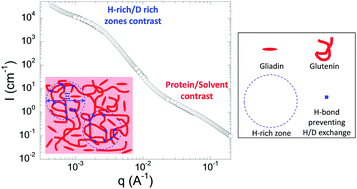Small angle neutron scattering contrast variation reveals heterogeneities of interactions in protein gels†
Abstract
We propose a quantitative approach to probe the spatial heterogeneities of interactions in macromolecular gels, based on a combination of small angle X-ray (SAXS) and neutrons (SANS) scattering. We investigate the structure of model gluten protein gels and show that the gels display radically different SAXS and SANS profiles when the solvent is (at least partially) deuterated. The detailed analysis of the SANS signal as a function of the solvent deuteration demonstrates heterogeneities of sample deuteration at different length scales. The progressive exchange between the protons (H) of the proteins and the deuteriums (D) of the solvent is inhomogeneous and 60 nm large zones that are enriched in H are evidenced. In addition, at low protein concentration, in the sol state, solvent deuteration induces a liquid/liquid phase separation. Complementary biochemical and structure analyses show that the denser protein phase is more protonated and specifically enriched in glutenin, the polymeric fraction of gluten proteins. These findings suggest that the presence of H-rich zones in gluten gels would arise from the preferential interaction of glutenin polymers through a tight network of non-exchangeable intermolecular hydrogen bonds.


 Please wait while we load your content...
Please wait while we load your content...